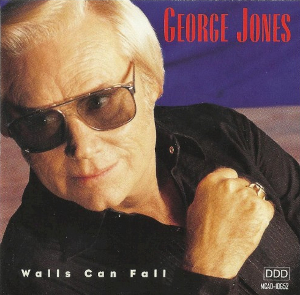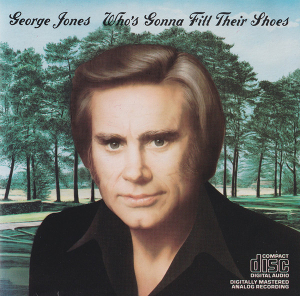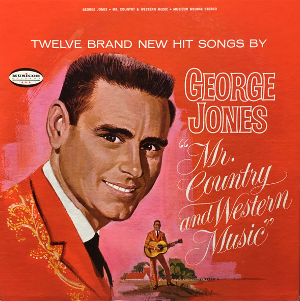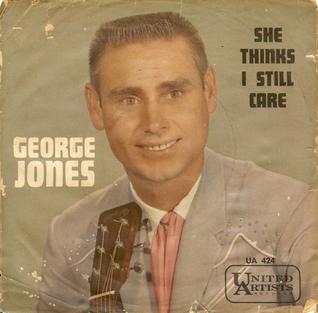Related Research Articles

"Honky Tonk Women" is a song by the English rock band the Rolling Stones. It was released as a non-album single on 4 July 1969 in the United Kingdom, and a week later in the United States. It topped the charts in both nations. The song was on Rolling Stone's 500 Greatest Songs of All Time list, and was inducted into the Grammy Hall of Fame.

One Woman Man is an album by American country music artist George Jones, released on February 28, 1989 on Epic Records.

Walls Can Fall is an album by American country music artist George Jones. This album was released in 1992 on the MCA Nashville Records. It peaked at number 24 on the Billboard Country Albums chart and number 77 on The Billboard 200 chart. Walls Can Fall went Gold in 1994.

Who's Gonna Fill Their Shoes is the 45th studio album by American country music artist George Jones, released in 1985 on the Epic Records label.

Mr. Country & Western Music is an album by American country music artist George Jones released in 1965 on the Musicor Records label.

Grand Ole Opry's New Star is the debut studio album released by George Jones in November 1956 with Starday Records. Produced by Jones' manager Pappy Daily, the album was recorded during early sessions in 1954, throughout 1955, and other sessions in 1956. It is also the first album to be released on the Starday label, a label only four years old.
"The Grand Tour" is a song made famous by country music singer George Jones. Originally released in 1974, the song was the title track to his album released that year. The song became Jones' sixth No. 1 song on Billboard's Hot Country Singles chart in August 1974, and was the fourth-biggest hit of the year. In 2014, Rolling Stone named the song number 38 on its "40 Saddest Country Songs of All Time".
"We Must Have Been Out Of Our Minds" is a song made famous as a duet by country music singers George Jones and Melba Montgomery. Originally released in 1963, the song became a Top 5 hit on the Billboard Hot Country Singles chart and a country music standard.

"Why Baby Why" is a country music song co-written and originally recorded by George Jones. Released in late 1955 on Starday Records and produced by Starday co-founder and Jones' manager Pappy Daily, it peaked at 4 on the Billboard country charts that year. It was Jones' first chart single, following several unsuccessful singles released during the prior year on Starday.
"White Lightning" is a song written by the rockabilly artist J. P. Richardson, best known by his stage name, the Big Bopper. The song was recorded by American country music artist George Jones and released as a single in February 1959. On April 13, 1959, Jones' version was the first number-one single of his career. The song has since been covered by numerous artists. Richardson never got to see the success of the record, as he had been killed in an airplane accident 6 days before its release.
"The Race Is On" is a song written by Don Rollins and made a hit on the country music charts by George Jones and on the pop and easy listening charts by the unrelated Jack Jones. George's version was the first single released from his 1965 album of the same name. Released as a single in September 1964, it peaked at number three on the Billboard Hot Country Singles chart and at number 96 on the Billboard Hot 100 in January 1965. Jack's version topped Billboard's Easy Listening chart and reached number 15 on the Hot 100 the same year. The two recordings combined to reach number 12 on the Cashbox charts, which combined all covers of the same song in one listing and thus gave George Jones his only top-40 hit. The song uses thoroughbred horse racing as the metaphor for the singer's romantic relationships.

"She Thinks I Still Care" is a country song written by Dickey Lee and Steve Duffy. The song was recorded by multiple artists, including George Jones, Connie Francis, Anne Murray, Elvis Presley and Patty Loveless.
"The Window Up Above" is a song written and originally recorded by American country music artist George Jones. The version recorded by Jones peaked at number #2 on the country charts and spent a total of 34 weeks on the chart. It became a #1 smash for Mickey Gilley in 1975.
"Still Doin' Time" is a song written by John Moffatt and Michael P. Heeney, and recorded by American country music artist George Jones. It was released in September 1981 as the first single from the album Still the Same Ole Me. The song was Jones' eighth number one country single as a solo artist. The single stayed at number one for one week and spent a total of ten weeks on the chart. Much like his previous hit single, "If Drinkin' Don't Kill Me ," the song seemed torn from the pages of the singer's life; drug-addled and paranoid, he often disappeared for weeks on end, missing show dates and confounding his managers. "Still Doin' Time," with its story of a man who is a prisoner of alcohol who cannot escape, rang true to critics and fans, many of whom were astonished at how effectively Jones could sing despite his condition. Professionally, he was thriving; in November 1982 CBS Records extended his recording contract, and in December, he was nominated in the Playboy readers' poll as the year's best male vocalist in the country and Western category.
"Same Ole Me" is a song written by Paul Overstreet, and recorded by American country music artist George Jones with The Oak Ridge Boys. It was released in January 1982 as the second single and partial title track from Jones' album Still the Same Ole Me. The song reached number 5 on the Billboard Hot Country Singles chart and number 1 on the RPM Country Tracks chart in Canada.
"Who's Gonna Fill Their Shoes" is a song written by Troy Seals and Max D. Barnes and recorded by American country music singer George Jones. It was released in June 1985 as the first single and title track from the album Who's Gonna Fill Their Shoes. The song peaked at number three on the Hot Country Singles chart.
"Loving You Could Never Be Better" is a song written by Earl Montgomery, Charlene Montgomery and Betty Tate, and recorded by American country music artist George Jones. It was released in April 1972 as the second single from his album George Jones . The song peaked at number 2 on the Billboard Hot Country Singles chart. It also reached number 1 on the RPM Country Tracks chart in Canada. The song was a good example of how producer Billy Sherrill had updated the sound of Jones' records, incorporating a laid back, R&B bass line. By drawing from such unlikely and disparate musical influences as Johann Strauss and "wall of sound" rock producer Phil Spector, he gradually began embroidering his own subtle permutations on the rather predictable fabric of country record production. "I just decided I'd do it my way, and screw 'em if they didn't like it," Jones biographer Bob Allen quotes Sherrill. "Back then, the musicians had their own repertoire of stock Nashville licks and chord progressions that would work on any song. But I often wanted something different, and I'd make 'em play it."
"Let's Invite Them Over" is a song written by Onie Wheeler, which was recorded as a duet by American country artists George Jones and Melba Montgomery. The song was released as the pair's second single in 1963.
"What Am I Worth" is a 1956 country music song released by George Jones, co-written by Jones and Darrell Edwards. The song was released on January 14, 1956 and was one of the fourteen songs included on Jones' debut album with Starday Records in 1957.
"Tell Me My Lying Eyes Are Wrong" is a song by George Jones. A "cheatin' song" written by Dallas Frazier and Sanger D. Shafer, it was released by Jones as a single on Musicor Records and peaked at No. 13 on the Billboard country music chart in 1970. Jones was becoming disenchanted with the production of his records, which were being issued at a furious pace. As Bob Allen points out in his book George Jones: The Life and Times of a Honky Tonk Legend, "During his time with Musicor, "George recorded more than over 280 songs - most of which were done in rushed, sloppily produced sessions - and help to establish for himself a somewhat unwelcome reputation as one of country music's most overrecorded artists."
References
- 1 2 Whitburn, Joel (2008). Hot Country Songs 1944 to 2008. Record Research, Inc. p. 244. ISBN 978-0-89820-177-2.
- ↑ Allen, Bob (1994). George Jones: the life and times of a honky tonk legend. Carol Publication Group. p. 304. ISBN 9781559722537.
- ↑ Carlin, Richard (2003). Country Music: A Biographical Dictionary. Taylor & Francis. p. 207. ISBN 9780415938020.
- ↑ Mansfield, Brian. "Walls Can Fall review". Allmusic. Retrieved 16 July 2012.
- ↑ Ching, Barbara (2001). Wrong's What I Do Best. p. 132. ISBN 9780195169423.
- ↑ Stambler, Irwin; Landon, Grelon (14 July 2000). Country Music: The Encyclopedia. Macmillan. p. 500. ISBN 9780312264871.
- ↑ "Top RPM Country Tracks: Issue 1827." RPM . Library and Archives Canada. January 23, 1993. Retrieved August 5, 2013.
- ↑ "George Jones Chart History (Hot Country Songs)". Billboard.